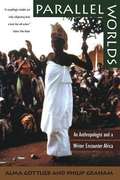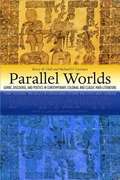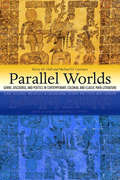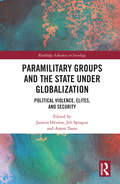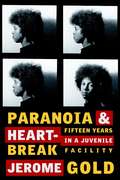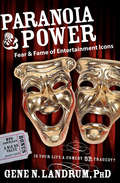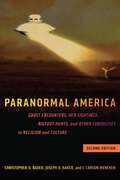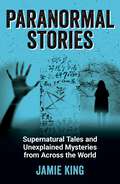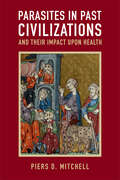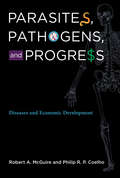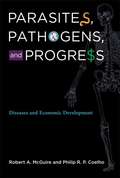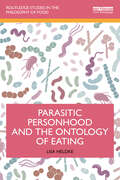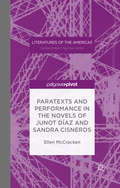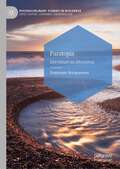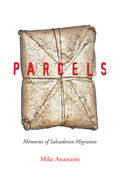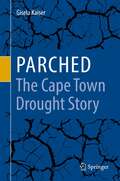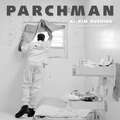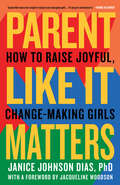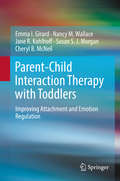- Table View
- List View
Parallel Worlds: An Anthropologist and a Writer Encounter Africa
by Philip Graham Alma GottliebThis suspenseful and moving memoir of Africa recounts the experiences of Alma Gottlieb, an anthropologist, and Philip Graham, a fiction writer, as they lived in two remote villages in the rain forest of Cote d'Ivoire. With an unusual coupling of first-person narratives, their alternate voices tell a story imbued with sweeping narrative power, humility, and gentle humor. Parallel Worlds is a unique look at Africa, anthropological fieldwork, and the artistic process. "A remarkable look at a remote society [and] an engaging memoir that testifies to a loving partnership . . . compelling. "—James Idema, Chicago Tribune
Parallel Worlds: Genre, Discourse, and Poetics in Contemporary, Colonial, and Classic Maya Literature
by Michael D. Carrasco Kerry M. HullDespite recent developments in epigraphy, ethnopoetics, and the literary investigation of colonial and modern materials, few studies have compared glyphic texts and historic Maya literatures. Parallel Worlds examines Maya writing and literary traditions from the Classic period until today, revealing remarkable continuities across time. In this volume, contributions from leading scholars in Maya literary studies examine Maya discourse from Classic period hieroglyphic inscriptions to contemporary spoken narratives, focusing on parallelism to unite the literature historically. Contributors take an ethnopoetic approach, examining literary and verbal arts from a historical perspective, acknowledging that poetic form is as important as narrative content in deciphering what these writings reveal about ancient and contemporary worldviews. Encompassing a variety of literary motifs, including humor, folklore, incantation, mythology, and more specific forms of parallelism such as couplets, chiasms, kennings, and hyperbatons, Parallel Worlds is a rich journey through Maya culture and pre-Columbian literature that will be of interest to students and scholars of anthropology, ethnography, Latin American history, epigraphy, comparative literature, language studies, indigenous studies, and mythology.
Parallel Worlds: Genre, Discourse, and Poetics in Contemporary, Colonial, and Classic Maya Literature (G - Reference, Information And Interdisciplinary Subjects Ser.)
by Michael D. Carrasco Kerry M. HullDespite recent developments in epigraphy, ethnopoetics, and the literary investigation of colonial and modern materials, few studies have compared glyphic texts and historic Maya literatures. Parallel Worlds examines Maya writing and literary traditions from the Classic period until today, revealing remarkable continuities across time. In this volume, contributions from leading scholars in Maya literary studies examine Maya discourse from Classic period hieroglyphic inscriptions to contemporary spoken narratives, focusing on parallelism to unite the literature historically. Contributors take an ethnopoetic approach, examining literary and verbal arts from a historical perspective, acknowledging that poetic form is as important as narrative content in deciphering what these writings reveal about ancient and contemporary worldviews. Encompassing a variety of literary motifs, including humor, folklore, incantation, mythology, and more specific forms of parallelism such as couplets, chiasms, kennings, and hyperbatons, Parallel Worlds is a rich journey through Maya culture and pre-Columbian literature that will be of interest to students and scholars of anthropology, ethnography, Latin American history, epigraphy, comparative literature, language studies, indigenous studies, and mythology.
Paramilitary Groups and the State under Globalization: Political Violence, Elites, and Security (Routledge Advances in Sociology)
by Jeb Sprague Jasmin Hristov Aaron TaussThis book examines the phenomenon of paramilitarism across Latin America and the Caribbean, Eastern Europe, Africa, and Asia, offering a nuanced perspective while identifying key patterns in the way paramilitary violence is implicated in processes of capital accumulation, state-building, and the reproduction of social power. Paramilitary violence, a key modality of coercion in the era of globalization, has been pursued by states and dominant classes in the Global South, to reproduce or extend their power over subaltern groups. Paramilitary groups are responsible for atrocities, including extrajudicial executions, disappearances, torture, rape, and forced displacement. The book integrates empirically rich investigations into an emergent theory of political violence, capturing the relationship between parastatal armed actors, capital, and the state. The analysis sheds light on globally relevant phenomena such as the end of the Cold War, the shifting role of US hegemony, and evolving nature of the nation-state. The book is suitable for academics, graduate and upper-year undergraduate students, and policy-makers in development, human rights, and violence prevention. Given its interdisciplinary subject, it appeals to scholars from a wide range of disciplines, including political science, sociology, political anthropology, development, peace and conflict, security and terrorism, international relations, and global studies.
Paranatures in Culinary Culture: An Alimentary Ecology
by Thomas R. ParkerUncovering the intricate cultural threads that inform our dietary practicesParanatures in Culinary Culture embarks on a gastronomic odyssey, redefining foods we thought we knew and revealing the extraordinary stories of ordinary ingredients and the cultural forces shaping our diets. The book begins with a simple premise: to eat is to assimilate the outer world into the inner body, both physically and mentally. But what happens when this assimilation process goes awry? Thomas R. Parker reveals how culinary staples are not only elements of identity formation but also instruments of cultural disruption when their true nature emerges and challenges our preconceptions. Parker explores how certain foods—bread, oysters, pigs, cheese, and wine—can both create and destabilize narratives, unsettle assimilation, and decenter Western culinary traditions. Taking inspiration from architectural historian David Gissen&’s concept of &“subnature&” and Michel Serres&’s idea of the &“parasite,&” Parker develops the concept of paranatures: flavors, foods, and practices considered unpalatable by different societies at different times. He reveals how certain ordinary foods live parallel paranatural lives, addressing larger issues of colonial and postcolonial food theory and challenging long-held notions that cuisine was meant to uphold. Serving up a rich blend of history, culture, and gastronomy, Parker leads readers to perceive food as an adventure, inviting them to taste the untamed side of nature. He offers a thought-provoking invitation to reconceptualize the roles and narratives we assign to the natural world and its produce, allowing us to see food, nature, and ourselves in new ways.
Paranoia & Heartbreak: Fifteen Years in a Juvenile Facility
by Jerome GoldFor fifteen years, Jerome Gold worked as a rehabilitation counselor in a prison for juveniles in Washington state. Throughout his time there, he kept a journal of his experiences with youths who had been incarcerated for murder, kidnap, assault, rape and other sex offenses, auto theft, burglary, and selling drugs. What started as a journal designed to relieve stress turned into the evocation of one man's nuanced perspective on a unique group of young people. Paranoia & Heartbreak tells Gold's personal story of coming to terms with people who have crossed over to the other side of their own humanity. Writing from ample experience and with unflinching compassion, Gold brings the reader to see these "deviants"--and through them, in some slanted way, our whole society, with an unexpected intensity.
Paranoia & Power: Fear & Fame of Entertainment Icons
by Gene N. LandrumA self-help work on the inhibiting inner fears that either motivate or debilitate. As a pundit once said, Hesitate and you are lost. Why do most people hesitate? Fear! The fear of not being good enough or the fear that comes from thinking too much. We are afraid of those things we don&’t understand, but the true visionaries jump right into those fears and they magically disappear. Fear was the fuel of the passions of Elvis. In the case of director Steven Spielberg, he had a deep-seated fear of the dark. The only time he wasn&’t afraid when in a theater where he escaped into the fantasy of make-believe. What did that have to with his accumulating two billion dollars? Plenty! As he told the media, when he was in his twenties he would get sort of nauseous stage fright—and his insecurities were the fuel for his stories. With examples ranging from Judy Garland to Bob Dylan, Madonna to Jack Nicholson, this book shows how fear can be the catalyst for ending up in the penthouse or the poorhouse, depending on how we deal with it.
Paranormal America (second edition): Ghost Encounters, UFO Sightings, Bigfoot Hunts, and Other Curiosities in Religion and Culture
by F. Carson Mencken Christopher D Bader Joseph O BakerAn &“engrossing and intellectually stimulating&” portrait of the countless Americans who believe in paranormal phenomena (Journal of Religion and Culture). Popular culture makes clear that there&’s a seemingly insatiable public appetite for information and entertainment about what we call the paranormal, supernatural, or mystical. But how many Americans believe in the paranormal, and who are they? Based on extensive research and their own unique experiences, Christopher Bader, Joseph Baker, and Carson Mencken reveal that a significant number hold these beliefs, and that for better or worse, we undoubtedly live in a paranormal America.Paranormal America follows the authors as they participate in psychic and palm readings, have their auras photographed, join a Bigfoot hunt, follow a group of celebrity ghost hunters as they investigate claims of a haunted classroom, and visit a support group for alien abductees. The second edition also includes new and updated research based on findings from the Baylor Religion Survey regarding America&’s relationship with the paranormal. Drawing on these diverse and compelling sources of data, the book offers an engaging account of the social, personal, and statistical stories of American paranormal beliefs and experiences. It examines topics such as the popularity of paranormal beliefs in the United States, the ways in which these beliefs relate to each other, whether paranormal beliefs will give rise to a new religion, and how believers in the paranormal differ from &“average&” Americans. Brimming with fascinating anecdotes and provocative new findings, Paranormal America offers an entertaining yet authoritative examination of a growing segment of American religious culture. &“An engaging and eye-opening book that offers an abundance of new insights, dispelling some popular stereotypes and reaffirming others.&” —Roger Finke, Distinguished Professor of Sociology and Religious Studies, Pennsylvania State University
Paranormal Media: Audiences, Spirits and Magic in Popular Culture
by Annette HillThe paranormal has gone mainstream.Beliefs are on the rise, with almost half of the British population, and two thirds of Americans, claiming to believe in extra sensory perceptions and hauntings. Psychic magazines like Spirit and Destiny, television shows such as Fringe, Ghost Whisperer and Most Haunted, ghost-cams and e-poltergeists, bestselling books on mind, body and spirit, and magicians like Derren Brown have moved from the outer limits to the centre of popular culture, turning paranormal beliefs and scepticism into revenue streams.Paranormal Media offers a unique, timely exploration of the extraordinary, unexplained and supernatural in popular culture, looking in unusual places in order to understand this phenomenon. Early spirit forms such as magic lantern shows or the spirit photograph are re-imagined as a search for extraordinary experiences in reality TV, ghost tourism, and live shows. Through a popular cultural ethnography, and critical analysis in social and cultural theory, this ground-breaking book by Annette Hill presents an original and rigorous examination of people's experiences of spirits and magic. In popular culture, people are players in an orchestral movement about what happens to us when we die. In a very real sense the audience is the show. This book is the story of audiences and their participation in a show about matters of life and death.Paranormal Media will be a highly interesting read for undergraduate and postgraduate students, as well as academics, on a wide range of television, media, cultural studies, and sociology courses.
Paranormal Stories: Supernatural Tales and Unexplained Mysteries from Across the World
by Jamie KingStep into the unknownTales of the paranormal have seduced us and spooked us for centuries, passed around from person to person and frequently retold and reimagined in books, films and TV. Whether they’re based on real events or they’re simply urban legends which have taken on a life of their own, the strange happenings, unexplained events and unsolved mysteries in this book will take you on a frightening journey to the outer limits of plausibility, and dare you to believe the unbelievable.Ranging from the mysterious to the macabre, the stories in this book span a broad range of supernatural subjects including ghosts, spirits and the undead, witchcraft and occultism, extraterrestrial life, mythical creatures, and much more.Whether you’re a believer or a sceptic, a paranormal junkie or an interested observer, let these stories spark your imagination, capture your curiosity and perhaps even send a shiver down your spine.
Paranormal Stories: Supernatural Tales and Unexplained Mysteries from Across the World
by Jamie KingStep into the unknownTales of the paranormal have seduced us and spooked us for centuries, passed around from person to person and frequently retold and reimagined in books, films and TV. Whether they're based on real events or they're simply urban legends which have taken on a life of their own, the strange happenings, unexplained events and unsolved mysteries in this book will take you on a frightening journey to the outer limits of plausibility, and dare you to believe the unbelievable.Ranging from the mysterious to the macabre, the stories in this book span a broad range of supernatural subjects including ghosts, spirits and the undead, witchcraft and occultism, extraterrestrial life, mythical creatures, and much more.Whether you're a believer or a sceptic, a paranormal junkie or an interested observer, let these stories spark your imagination, capture your curiosity and perhaps even send a shiver down your spine.
Paranormale Behauptungen auf dem Prüfstand: Von Wünschelruten, Elektrosmog und Parapsychologie
by Michael JachanDieses Sachbuch bietet eine tiefgehende und verständliche Einführung in die Welt der Wissenschaft und Pseudowissenschaften. Mit praktischen Anleitungen zur Durchführung von Psi-Tests zu Hause, die nur Papier, Bleistift und eine Münze benötigen, vermittelt es auf einfache Weise die Prinzipien wissenschaftlicher Untersuchungen. Lerne, wie Wissenschaftler*innen im Labor arbeiten, und, wie diese Techniken auf alltägliche Behauptungen angewendet werden können. Erfahre etwas über die skurrilen und oft irrtümlichen Überzeugungen, die auch renommierte Wissenschaftler*innen immer wieder hegen. Mit Themen wie Pseudowissenschaft, Doppelblindversuch, Placebo-Effekt, Psi-Test, Elektrosensibilität, Geistheilung und mehr, spannt das Buch einen Bogen von den alten Griechen über Isaac Newton bis ins 21. Jahrhundert. Es vermittelt die Grundlagen der Wissenschaftsgeschichte sowie -theorie und bietet einen praxisnahen Einblick in die Durchführung von Experimenten. Ein besonderes Augenmerk liegt auf der Problemlösung: Leser*innen werden befähigt, sich und ihr Umfeld vor Scharlatan*innen zu schützen, indem sie lernen, paranormale Behauptungen kritisch zu hinterfragen. Entdecke, ob hinter Esoterik und Pseudomedizin tatsächlich etwas steckt und wie du mit wissenschaftlichen Methoden zu einer fundierten Beurteilung gelangen kannst.
Parascientific Revolutions: The Science and Culture of the Paranormal (Proximities)
by Derek LeeUnraveling the hidden influence of the paranormal on science, literature, and belief Telepathy, clairvoyance, precognition, and telekinesis: these attributes of the paranormal mind are widely dismissed as nonsense, but what can an exploration of such pseudoscientific phenomena tell us about accepted scientific and cultural thought? In Parascientific Revolutions, Derek Lee traces the evolution of psi epistemologies across the twentieth and twenty-first centuries to uncover how these ideas have migrated into scientific fields such as quantum physics and neurology, as well as diverse literary genres including science fiction, ethnic literature, and even government training manuals. Lee introduces the groundbreaking concept of &“parascience,&” a dynamic cultural space where ideas rejected by the scientific establishment blend with alternative strains of literary, mythic, and philosophical thought to regenerate and return to mainstream discourse. From early modernist works by James Joyce to postwar speculative fiction by Philip K. Dick to ethnofuturist narratives by Ruth Ozeki, Parascientific Revolutions demonstrates how cultural and intellectual currents reshape paranormal ideas over time. Examining psychic surveillance programs like Project Stargate and bizarre particles of extrasensory perception such as the psitron, Lee illustrates the ways paranormal concepts persist and evolve to influence culture. Presenting pseudoscience as an inevitable by-product of the scientific process, Parascientific Revolutions offers fresh insight into how the paranormal mind continually challenges our understanding of knowledge and belief. It invites readers to reconsider the boundaries between science and the unknown, revealing a world where speculative thought and empirical investigation are deeply intertwined. Retail e-book files for this title are screen-reader friendly with images accompanied by short alt text and/or extended descriptions.
Parasites in Past Civilizations and Their Impact upon Health
by Piers D. MitchellParasites have been infecting humans throughout our evolution. When complex societies developed, the greater population density provided new opportunities for parasites to spread. In this interdisciplinary volume, the author brings his expertise in medicine, archaeology and history to explore the contribution of parasites in causing flourishing past civilizations to falter and decline. By using cutting edge methods, Mitchell presents the evidence for parasites that infected the peoples of key ancient civilizations across the world in order to understand their impact upon those populations. This new understanding of the archaeological and historical evidence for intestinal worms, ectoparasites, and protozoa shows how different cultures were burdened by contrasting types of diseases depending upon their geographical location, endemic insects, food preferences and cultural beliefs.
Parasites, Pathogens, and Progress: Diseases and Economic Development
by Robert A. McGuire Philip R. CoelhoThe crucial role played by diseases in economic progress, the growth of civilizations, and American history.In Parasites, Pathogens, and Progress, Robert McGuire and Philip Coelho integrate biological and economic perspectives into an explanation of the historical development of humanity and the economy, paying particular attention to the American experience, its history and development. In their path-breaking examination of the impact of population growth and parasitic diseases, they contend that interpretations of history that minimize or ignore the physical environment are incomplete or wrong.The authors emphasize the paradoxical impact of population growth and density on progress. An increased population leads to increased market size, specialization, productivity, and living standards. Simultaneously, increased population density can provide an ecological niche for pathogens and parasites that prey upon humanity, increasing morbidity and mortality. The tension between diseases and progress continues, with progress dominant since the late 1800s.Integral to their story are the differential effects of diseases on different ethnic (racial) groups. McGuire and Coelho show that the Europeanization of the Americas, for example, was caused by Old World diseases unwittingly brought to the New World, not by superior technology and weaponry. The decimation of Native Americans by pathogens vastly exceeded that caused by war and human predation.The authors combine biological and economic analyses to explain the concentration of African slaves in the American South. African labor was more profitable in the South because Africans' evolutionary heritage enabled them to resist the diseases that became established there; conversely, Africans' ancestral heritage made them susceptible to northern “cold-weather” diseases. European disease resistance and susceptibilities were the opposite regionally. Differential regional disease ecologies thus led to a heritage of racial slavery and racism.
Parasites, Pathogens, and Progress: Diseases and Economic Development
by Robert A. Mcguire Philip R. P. CoelhoIn Parasites, Pathogens, and Progress, Robert McGuire and Philip Coelho integrate biological and economic perspectives into an explanation of the historical development of humanity and the economy, paying particular attention to the American experience, its history and development. In their path-breaking examination of the impact of population growth and parasitic diseases, they contend that interpretations of history that minimize or ignore the physical environment are incomplete or wrong. The authors emphasize the paradoxical impact of population growth and density on progress. An increased population leads to increased market size, specialization, productivity, and living standards. Simultaneously, it can provide an ecological niche for pathogens and parasites that prey upon humanity, increasing morbidity and mortality. The tension between diseases and progress continues, with progress dominant since the late 1800s. Integral to their story are the differential effects of diseases on different ethnic (racial) groups. McGuire and Coelho show that the Europeanization of the Americas, for example, was caused by Old World diseases unwittingly brought to the New World, not by superior technology and weaponry. The decimation of Native Americans by pathogens vastly exceeded that caused by war and human predation. The authors combine biological and economic analyses to explain the concentration of African slaves in the American South. African labor was more profitable in the South because Africans' evolutionary heritage enabled them to resist the diseases that became established there; conversely, Africans' ancestral heritage made them susceptible to northern "cold-weather" diseases. European disease resistance and susceptibilities were the opposite regionally. Differential regional disease ecologies thus led to a heritage of racial slavery and racism.
Parasitic Personhood and the Ontology of Eating (Routledge Studies in the Philosophy of Food)
by Lisa HeldkeHumans must eat, and our eating involves us in a cascade of eating relationships that leave life and death biting into each other.These realities should—but often do not—profoundly shape our understanding of personhood. This book explores “parasitic personhood,” an alternative to atomistic individualism that acknowledges the biological individual as a network of persistent biological relationships (a “holobiont”) and draws insight from the astonishing frequency and variety of parasitic feeding relationships. What happens to our conception of personhood if we consider parasitism as more than just a threat to our health? Parasitism is a remarkably common form of life; however, we tend to think of parasites only as dangerous pestilential organisms that should be eliminated. What if parasitism—in particular, persistent eating relationships that threaten to destabilize host organisms—were instead the model in terms of which we understood what it means to be a person? What if we acknowledged the ineliminability—indeed, the centrality—of parasitism to life and embraced both the persistent eating and the precarity that they entail as central to our understanding of personhood? In advocating for parasitic personhood, this book joins a history of efforts to uproot atomistic individualism, the remarkably durable understanding of personhood that is aptly portrayed by its most well-known eighteenth-century model, the billiard ball: smoothly self-contained, with relationships decidedly external to it. The parasitic alternative conceives persons as collections of organisms in relationships that are, by turns and all at once, essential, precarious, definitive, destabilizing, stable, and shifting. The book asks: in what does parasitic personhood consist? It goes on to examine some implications of this conception of personhood: how is moral agency constituted for the parasitic person, and how does parasitic personhood expand our understanding of aesthetic engagement and appreciation? This book will absorb anyone who is interested in thinking about the metaphysical significance of their need to eat and their reliance on myriad other organisms to enable them to do so.It will engage students and scholars of food and eating, particularly those working on the metaphysics of food, food and personhood, fermentation, and the microbiome, as well as philosophers considering the ontological significance of food and eating.
Paratexts and Performance in the Novels of Junot Díaz and Sandra Cisneros (Literatures of the Americas)
by Ellen McCrackenPart of a new phase of post-1960s U.S. Latino literature, The Brief Wondrous Life of Oscar Wao by Junot Díaz and Caramelo by Sandra Cisneros both engage in unique networks of paratexts that center on the performance of latinidad. Here, Ellen McCracken re-envisions Gérard Genette's paratexts for the present day, arguing that the Internet increases the range, authorship, and reach of the paratextual portals and that they constitute a key element of the creative process of Latino literary production in 21st century America. This smart and useful book examines how both novelists interact with the interplay of populist and hegemonic multiculturalism and allows new points of entry into these novels.
Paratopia: Literature as Discourse (Postdisciplinary Studies in Discourse)
by Dominique MaingueneauThis book presents Maingueneau’s notion of paratopia and its application to literary discourse. Unlike most discourse analysts, who pay little attention to literature, the author argues that a discourse analytical perspective allows us to challenge the usual separation between textual and contextual approaches to works. Considered as an impossible belonging, paratopia is a condition of possibility of literature, of the subjects who occupy a writer's position and of the use they make of language. To find their place as creators, writers must elaborate their own paratopia, they must give it shape and meaning. Their works must both construct a certain world and, through paratopic shifters, reflect and legitimise the conditions of their own appearance. Paratopia is an invariant of literature, but it takes different forms throughout history: writers draw on their paratopic potential to appropriate the resources made available to them by literary discourse in their own time. Today, the development of digital technologies and research on gender prompts us to take a different look at traditional forms of paratopia. The corpus includes canonical and recent texts, mainly from Western literature. It will be of interest to students and scholars in literary studies, discourse studies (discourse theory and discourse analysis), and sociology of culture.
Parcels: Memories of Salvadoran Migration (Latinidad: Transnational Cultures in the)
by Mike AnastarioIn light of new proposals to control undocumented migrants in the United States, Parcels prioritizes rural Salvadoran remembering in an effort to combat the collective amnesia that supports the logic of these historically myopic strategies. Mike Anastario investigates the social memories of individuals from a town he refers to as “El Norteño,” a rural municipality in El Salvador that was heavily impacted by the Salvadoran Civil War, which in turn fueled a mass exodus to the United States. By working with two viajeros (travelers) who exchanged encomiendas (parcels containing food, medicine, documents, photographs and letters) between those in the U.S. and El Salvador, Anastario tells the story behind parcels and illuminates their larger cultural and structural significance. This narrative approach elucidates key arguments concerning the ways in which social memory permits and is shaped by structural violence, particularly the U.S. actions and policies that have resulted in the emotional and physical distress of so many Salvadorans. The book uses analyses of testimonies, statistics, memories of migration, the war and, of course, the many parcels sent over the border to create an innovative and necessary account of post-Civil War El Salvador.
Parched - The Cape Town Drought Story
by Gisela KaiserThe book presents the history of water supply to Cape Town, leading up to the worst ever drought recorded, through political turmoil impacting on drought interventions and resulting in the adoption of an integrated water strategy.Regions reliant on water supply from rainfed dams have always been vulnerable to the impact of drought. This is exacerbated by the uncertainty of future rainfall, which is never guaranteed, and reliance is placed on modelling using historic data. While weather has always been variable, climate has been generally reliable. With anthropogenic activity causing changes in climate, the validity of modelling based on history is currently not fully trusted. Unless the storage capacity is sufficient to carry through numerous seasons of poor rainfall, even with water restrictions to match demand and supply in times of depleted rainfall, the risk of reservoirs running dry remains a threat.
Parchman
by R. Kim RushingConstructed in 1904, the Mississippi State Penitentiary at Parchman covers 20,000 acres, forty-six square miles, in the heart of the Mississippi Delta. Originally designed like a private plantation without walls or guard towers, the prison farm has been slowly transformed over the decades into a modern penitentiary. In 1994, photographer R. Kim Rushing was the first outside photographer in Parchman's history allowed long-term access to inmates and the chance to photograph them in their cells and living quarters after earning great trust with his subjects. In Parchman he offers a glimpse of the men incarcerated in this infamous place. Eighteen volunteer inmates, ranging in custody level from trusty to death row, are presented through images and their own handwritten letters. When Rushing started this work, he brought visceral, human questions. What is it like to be an inmate in Parchman Penitentiary? What happens to an individual there? How does it happen? How do the prisoners feel about their circumstances? What does it feel like when two people from completely different worlds look at each other over the top of a camera? Moving to Ruleville, Mississippi, a small town in the heart of the Delta, Rushing came face to face with the influence of Parchman State Penitentiary. After becoming known in the area, he was allowed to photograph inmates for almost four years. These men volunteered and permitted him to photograph them in their cells. They even shared their written thoughts about their lives and prison conditions. It is particularly fascinating to see the visible change, or lack thereof, that becomes obvious when viewing portraits separated by two or three years. These stark, moving portraits of prisoners attest to the impact of photography. The photos are accompanied by the prisoners' stories, told in their own words. Together the images and words provide the most complete understanding of Parchman ever published.
Parent Like It Matters: How to Raise Joyful, Change-Making Girls
by Janice Johnson DiasAn accessible blueprint to embolden our daughters to be critical thinkers, fearless doers, and joyful change agents for our future—from the proud mother of teen activist Marley Dias, founder of 1000BLACKGIRLBOOKS.&“A stunning and pathbreaking how-to guide and memoir for every mom, dad, or caregiver who believes in rearing children to be healthy individuals and caring citizens.&”—Khalil Gibran Muhammad, author of The Condemnation of Blackness Renowned sociologist Dr. Janice Johnson Dias has devoted her life to nurturing and training girls to become change-makers—whether through her investment in her daughter Marley&’s humanitarian projects or through her work with the GrassROOTS Community Foundation&’s &“SuperCamp.&” In these unprecedented times, her work has never been more urgent, as parents find themselves asking: How do we teach our children to change the world? Dr. Johnson Dias knows that self-realized girls are created through intentional parenting. And so she asks parents to make deliberate choices—from babyhood through adolescence—that will give their girls the resources and foundation to take hold of their own futures and to create sustainable social change. Unlike other parenting experts, Dr. Johnson Dias doesn&’t urge parents to focus solely on their children. Instead, she tasks them with a personal challenge: to find their own joy. Just as Dr. Johnson Dias brings her own jubilant passion to parenting, mentoring, and teaching, she inspires caregivers to do the same. Using cutting-edge research and Dr. Johnson Dias&’s own experiences, Parent Like It Matters offers information and strategies for making discussions of racism and sexism a daily practice, identifying heroes and mentors, educating yourselves together, and uncovering your girl&’s passions and what issues drive her the most. Parenting is enormous work; it can be as overwhelming as it is fulfilling. Within the pages of Parent Like It Matters, parents will find the invaluable tools they need to raise resilient, optimistic girls who determine for themselves what their world will look like.
Parent-Child Interaction Therapy
by Cheryl Bodiford Mcneil Toni L. Hembree-KiginOver the past two decades, Parent-Child Interaction Therapy (PCIT) emerged as a leading-edge method for helping parents improve their children's disruptive and oppositional behavior. Today, PCIT has a robust evidence base; is used across the country in settings as diverse as hospitals, mental health centers, schools, and mobile clinics; and is rapidly gaining popularity in other parts of the world. In keeping with this increasing recognition of PCIT's effectiveness, the authors of Parent-Child Interaction Therapy present this expanded clinical edition to keep readers up to date on new practice developments, current treatment protocols, and the latest research findings. This update retains the fundamentals as detailed by PCIT's founder, Dr. Sheila Eyberg, including an overview of the therapy, detailed description of the course of treatment, and handout materials. The text goes further to explore the evolution of PCIT outside the original target ages of three-to-six (including preventive PCIT for very young children at risk) and examines the use of PCIT with special child populations, such as abuse victims and those with ADHD. Contributing experts discuss uses of the therapy in school, at home, with minorities, and with highly stressed families. But regardless of the population, setting, or topic covered, interventions remain faithful to basic PCIT principles and methods. New features of the expanded second edition include: Adaptations of PCIT for babies, toddlers, preteens, and siblings.Applications for abuse survivors, children with developmental disabilities, ADHD, and severe aggression problems. Uses of PCIT with separating or divorced parents.Culturally relevant PCIT for ethnic minority and international families.Teacher-child, staff-child, and home-based applications.PCIT training guidelines.A brand-new chapter summarizing current research supporting PCIT.As PCIT broadens its scope, Parent-Child Interaction Therapy, Second Edition, brings innovative ideas and proven techniques to clinical child psychologists, school psychologists, and other mental health providers working to enhance the lives of children and their families.
Parent-Child Interaction Therapy with Toddlers: Improving Attachment and Emotion Regulation
by Emma I. Girard Nancy M. Wallace Jane R. Kohlhoff Susan S. Morgan Cheryl B. McNeilThis book presents an early treatment model for toddlers. It describes the early life span development, trajectory, and future potential of toddlers and how it may be powerfully influenced by the protection and guidance of caregivers to meet toddlers’ physical and mental health needs. It offers an in-depth guide toParent-Child Interaction Therapy with Toddlers (PCIT-T), an evidence-based program for addressing and preventing behavior problems affecting young children’s development. The book details the innovative intervention design and how it guides clinicians in providing treatment for 12-month old to 24-month old toddlers with disruptive behaviors in addition to being used as a prevention model for caregivers experiencing stress of child rearing. PCIT-T focuses on core areas of social and emotional development, including behavior management and language skills, and can be used in dealing with difficulties as diverse as tantrums, language issues, autistic behaviors, and separation anxiety. Play therapy and compliance training in child-directed as well as parent-directed sessions are also examined. Initial chapters provide an overview of attachment and behavioral theory components that are foundational to the treatment model. Subsequent chapters provide a session-by-session guide and clinical manual for implementation of PCIT-T as well as the clinician tools needed to monitor treatment integrity and fidelity to the model. Topics featured in this book include:Core elements and treatment goals of PCIT-TA range of behavioral assessments used in PCIT-T.Instructions for room set-up, toy selection, and special considerations when providing PCIT-T treatment.Preparation guides for the pretreatment interview, assessment sessions, and weekly coaching sessions.The importance of child-directed interaction toddler (CDI-T) and parent-directed interaction toddler (PDI-T) in teaching children the necessary skills to regulate their emotions and develop self-control. Parent-Child Interaction Therapy with Toddlers is a must-have resource for clinicians and related professionals, researchers and professors, and graduate students in the fields of clinical child and school psychology, social work, pediatrics, infancy and early childhood development, child and adolescent psychiatry, primary care medicine, and related disciplines.
